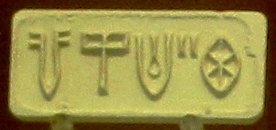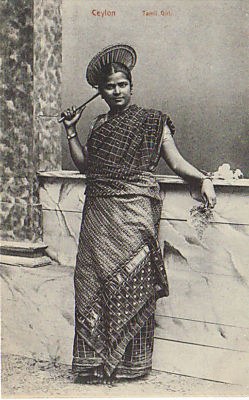
Brahmi is a writing system of ancient South Asia that appeared as a fully developed script in the third century BCE. Its descendants, the Brahmic scripts, continue to be used today across South and Southeast Asia.

The Indus script, also known as the Harappan script, is a corpus of symbols produced by the Indus Valley Civilisation. Most inscriptions containing these symbols are extremely short, making it difficult to judge whether or not they constituted a writing system used to record the as-yet unidentified language(s) of the Indus Valley Civilisation. Despite many attempts, the 'script' has not yet been deciphered, but efforts are ongoing. There is no known bilingual inscription to help decipher the script, which shows no significant changes over time. However, some of the syntax varies depending upon location.

Eelam is the native Tamil name for the South Asian island now known as Sri Lanka. Eelam is also the Tamil name for the spurge, toddy and gold.

Sri Lankan Tamils, also known as Ceylon Tamils or Eelam Tamils, are Tamils native to the South Asian island state of Sri Lanka. Today, they constitute a majority in the Northern Province, form the plurality in the Eastern Province and are in the minority throughout the rest of the country. 70% of Sri Lankan Tamils in Sri Lanka live in the Northern and Eastern provinces.

Tamilakam is the geographical region inhabited by the ancient Tamil people, covering the southernmost region of the Indian subcontinent. Tamilakam covered today's Tamil Nadu, Kerala, Puducherry, Lakshadweep and southern parts of Andhra Pradesh and Karnataka. Traditional accounts and the Tolkāppiyam referred to these territories as a single cultural area, where Tamil was the natural language and permeated the culture of all its inhabitants. The ancient Tamil country was divided into kingdoms. The best known among them were the Cheras, Cholas, Pandyans and Pallavas. During the Sangam period, Tamil culture began to spread outside Tamilakam. Ancient Tamil settlements were also established in Sri Lanka and the Maldives (Giravarus).

Tamil-Brahmi, also known as Tamili or Damili, was a variant of the Brahmi script in southern India. It was used to write inscriptions in the early form of Old Tamil. The Tamil-Brahmi script has been paleographically and stratigraphically dated between the third century BCE and the first century CE, and it constitutes the earliest known writing system evidenced in many parts of Tamil Nadu, Kerala, Andhra Pradesh and Sri Lanka. Tamil Brahmi inscriptions have been found on cave entrances, stone beds, potsherds, jar burials, coins, seals, and rings.

The earliest undisputed deciphered epigraphy found in the Indian subcontinent are the Edicts of Ashoka of the 3rd century BCE, in the Brahmi script.

There are literary, archaeological, epigraphic and numismatic sources of ancient Tamil history. The foremost among these sources is the Sangam literature, generally dated to 5th century BCE to 3rd century CE. The poems in Sangam literature contain vivid descriptions of the different aspects of life and society in Tamilakam during this age; scholars agree that, for the most part, these are reliable accounts. Greek and Roman literature, around the dawn of the Christian era, give details of the maritime trade between Tamilakam and the Roman empire, including the names and locations of many ports on both coasts of the Tamil country. There are evidences as could be seen comparing standard forms of Sumerian literature and those recovered through present form of Tamil, for example the word for father in Sumerian transliteration is given as, "a-ia" that could easily be compared with Tamil word, "ayya". This also places ancient form of Tamil to early Sumerian period, say as ancient as 3500 BC.
Thiriyai is a small village in the eastern Trincomalee District of Sri Lanka. It is situated about 25 miles north of Trincomalee town through Nilaveli. The total population of the village is 640 at the 2012 census.

The prehistory of Sri Lanka covers the Palaeolithic, Mesolithic and early Iron Age of the country until the Pre Anuradhapura period in 543 BC.
Kandarodai is a small hamlet and archaeological site of Chunnakam town, a suburb in Jaffna District, Sri Lanka.

The Anuradhapura period was a period in the history of Sri Lanka of the Anuradhapura Kingdom from 377 BCE to 1017 CE. The period begins when Pandukabhaya, King of Upatissa Nuwara moved the administration to Anuradhapura, becoming the kingdom's first monarch. Anuradhapura is heralded as an ancient cosmopolitan citadel with diverse populations.
Tissamaharama inscription No. 53 refers to a fragment of black and red ware flat dish inscribed in Brahmi script excavated at the earliest layer in southern town of Tissamaharama in Sri Lanka. It is dated to approximately 200 BC by German scholars who undertook the excavation.
Kudiramalai is a cape and ancient port town on the west coast of Sri Lanka.
When to date the start of the history of the Jaffna kingdom is debated among historians.

Tamil settlement of Sri Lanka refers to the settlement of Tamils, or other Dravidian peoples, from Southern India to Sri Lanka. Due to Sri Lanka's close proximity to Southern India, Dravidian influence on Sri Lanka has been very active since the early Iron Age or megalithic period.
Professor Karthigesu Indrapala is a Sri Lankan academic, historian, archaeologist, author and former dean of the Faculty of Arts, University of Jaffna.
Megalithic markings, megalithic graffiti marks, megalithic symbols or non-Brahmi symbols are markings found on mostly potsherds found in Central India, South India and Sri Lanka during the Megalithic Iron Age in India. A number of scholars have tried to decipher the symbols since 1878, and currently there is no consensus as to whether they constitute undeciphered writing or graffiti or symbols without any syllabic or alphabetic meaning.

This is a list of archaeological artefacts and epigraphs which have Tamil inscriptions. Of the approximately 100,000 inscriptions found by the Archaeological Survey of India in India, about 60,000 were in Tamil Nadu
Tamil inscriptions in Sri Lanka date from the centuries before Christ to the modern era. The vast majority of inscriptions date to the centuries following the 10th century AD, and were issued under the reigns of both Tamil and Sinhala rulers alike. Out of the Tamil rulers, almost all surviving inscriptions were issued under the occupying Chola dynasty, whilst one stone inscription and coins of the Jaffna Kingdom have also been found.














